#power and dominance in the relationship is something the film wrestles with as well
Explore tagged Tumblr posts
Text
Definitely A Choice to have Dennis listen to two different love songs when he’s alone in his car. One, when he’s picking up Arnie for the first time (“Not Fade Away”) and the other when he drops him off at home for what will be the last time in the film (“Runaway”).
They’re both about an ardent, enduring love that appears to be one-sided; yearning for the object of their affection to accept that love and be with or return to them. Dennis starts the film confident in his relationship with Arnie, that the love is strong and won’t fade, but when Christine enters the picture, realizes that his love has run away from him, that it wasn’t enough for Arnie.
#yeah yeah i’m thinking too much about this#christine#christine 1983#dennis guilder#arnie cunningham#dennis/arnie#what’s important to note is how music is presented and utilized in the film#it’s Christine’s primary method of communicating her emotions#stands to reason that the songs we hear in other cars serve the same purpose#and therefore we have dennis pining for arnie yet unable to articulate those feelings so the music spells it out for us#and while i know they’re both contemporary to the 70s and would therefore be on the radio#i also find the use of covers by women interesting as well#power and dominance in the relationship is something the film wrestles with as well#don’t even get me started on color theory and costume design or we’ll be here all night#i’ll just say this: red and blue are reaaaaally significant for dennis and arnie
20 notes
·
View notes
Text
Hobbs & Shaw review (Yeah, this is going to be long)
The Preamble (feel free to skip)
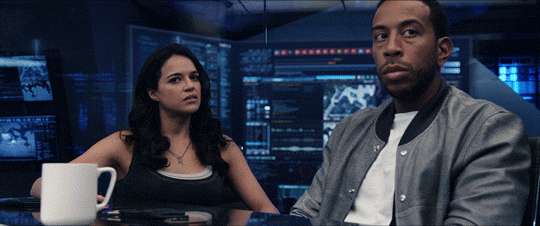
I was on the fence about going to see the new Fast & Furious spinoff, Hobbs & Shaw. Why? Because I’m a legit fan of the F&F franchise, and I was none too happy about the fact that Vin Diesel invited Dwayne to be a part of the franchise as they were friends at the time, but Dwayne’s fans -- mostly denizens of The Rock who think he can do no wrong -- preceded to treat Vin like he was second fiddle to Dwayne ever since Fast Five. Dwayne, then over the course of 3 films, preceded to get the big(ger) head and show his ass on the set of the last film, and usurped Vin’s franchise right out from under him.
What pissed me off more than that was the fact that after Dwayne and Vin got into it, the public not knowing any details or verification on what specifically happened on the set, decided to automatically take Dwayne’s side because ... “Hey! He’s the Rock and we like it when he plays characters that are only a slight variation on his persona when he wrestled full time in the WWE.” There was no concern for right or wrong. No desire to ask both of these Alpha males to put their egos aside. No inclination to actually wait and learn about what really went down. No, the general public has since decided to brand Vin Diesel a joke with no acting skill or talent to speak of.
Gone was Vin’s reputation as a scriptwriter, a producer and as a man who helped reinvent this franchise to turn it into something beyond simple street racing and a small found family making it happen in a hostile world. Honest Movie Trailers mocked Vin for taking the franchise seriously and actually putting time, love and effort into making sure each film had heart, not just great action scenes that defy the laws of physics and common sense.
Dwayne has become a better actor than he was 15 years ago. I can name about 4 or 5 movies where his performance is pretty good. But Vin was always a good actor. Not great. But definitely stronger than he was given credit for once people started associating him with nothing but action films. On top of that, he was a writer and he knew how to create an environment that people of disparate personalities loved working together and being a part of the franchise.
Flash forward to Hobbs & Shaw. There are no members of any of the F&F’s previous films in this movie. Tyrese called out Dwayne on social media for being selfish and greedy, because all of the other cast members were offered spinoffs too. But they turned them down because they wanted to work as a team. That’s how much the franchise means to them. Dwayne clearly had no sense of that loyalty, and obviously his biggest fans don’t have any expectations of him to have any either.
I’m still a fan of Dwayne Johnson, but not as much as I used to be, say 6 or 7 years ago. I still think he’s an immensely generous person when it comes to his fans, and he is a hell of an entertainer. But this situation involving Hobbs & Shaw, combined with some of his comments and behavior regarding sociopolitical events taking place in America over the last 5 years have reminded me that he is not without flaws, and should not be regarded as if he is above impunity.
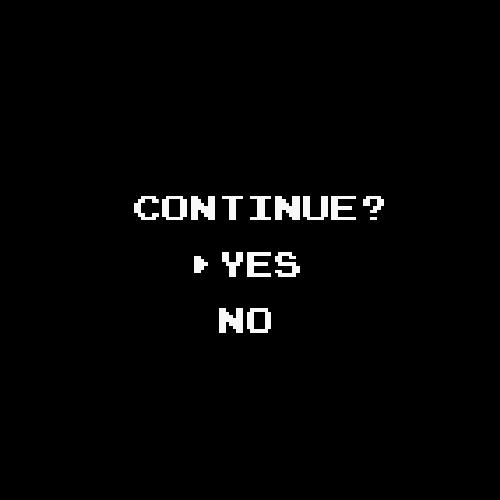
So Then What Happened?
Despite my misgivings about how the Hobbs & Shaw spinoff came about, I finally decided to go see it at the last minute for a few reasons:
I’ve had a particularly hard week and I needed to do something to blow off some steam.
I’m a huge fan of Jason Statham. I mean huge. I’m an action film fan in general, but Jason is one of my favorites in the genre. And it takes a lot of negatives to make me not go see one of his films.
I adore Helen Mirren. Even if I knew her part would be small, I also knew I would love seeing her play off of Jason again. Their scene together in Fate of the Furious/Furious 8 was the highlight of the film for me (followed by the brief return of Luke Evans).
I like Idris Elba. And he’s proven that whether playing a good guy or bad guy, he goes all in. Plus, I like him best as a bad guy.
I like Roman Reigns, and I wanted to be supportive of his first time on the silver screen.
So there it is. I’m a woman of integrity, but apparently, my integrity fades at the thought of actors I like getting to share a screen together. Feel free to judge me.
Now ... to the review
Hobbs & Shaw is exactly what you expect it to be. It doesn’t feel like it’s a part of the Fast & Furious franchise at all, but maybe that’s intentional. I think at the end of the day, audiences expect a F&F film to involve a cohesive, diverse team and something happening that changes your perspective about what you thought was going to happen. At least that’s been the franchise's m.o. since the fourth movie.
But Hobbs & Shaw keeps a lot of the other elements of the F&F franchise alive. Namely, a solid mix of comedy and action, at least one woman who makes you feel both inspired and afraid, and just a lot of action sequences that test the suspension of disbelief. Oh yeah, and at least one kickass car chase. And that’s exactly what we get, plus a little more.
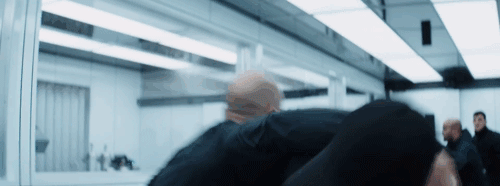
Here’s what I think worked, what didn’t, and what I loved (Warning: spoilers below):
What Worked For Me
Hobbs & Shaw is first and foremost an action film, but keeping with the Fast & Furious theme of family, the heart of the film takes us back to the connection and power of family. Unlike the original series, where family was defined as the people you find along the way, Hobbs & Shaw is more about bloodline and reconnecting with estranged family. For Hobbs, his family in Samoa. For Shaw, his relationship with his sister, Hattie, who believed that he had betrayed his country and his brothers- and sisters-in-arms. I’m glad they kept that aspect in, even though I liked the F&F’s original theme a little better.
I don’t know if it’s fair to call them cameos because they have more than one scene in the film, but the addition of Ryan Reynolds and Kevin Hart was a great move. Both are in the film long enough, but not too long. And each are given enough room to deliver what they do best.
The opening sequence showing Hobbs and Shaw starting their day is the perfect introduction to this spinoff. I loved the juxtaposition. If I had to choose a preferred lifestyle, I’d go with Shaw’s routine, but in sunny California.
Ryan Reynolds’ character’s name is Locke. I see what you did there. ;-)
Mama Hobbs throwing her flip flop at Cliff Curtis and hitting him in the face. What is it about brown mamas whipping shoes at their kids? LOL!
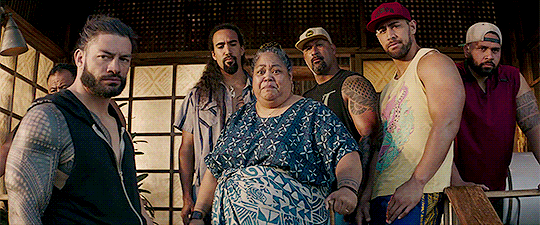
What Didn’t Work For Me
Was Brixton’s ambush of the CIA black site (which didn’t look too black to me) and kidnapping Hattie by running down the face of the building really the most efficient plan and escape? He literally picks her up, carries her on his shoulders, and runs down (with harness attached) the face of the building. It just seemed like it provided way too much of an opportunity for Hobbs & Shaw to catch up to him and for them to get her back. I love a great action sequence, but this one really makes the villain look impractical and hella extra.
Soooooooo, when Hattie is hooked up to the device to extract the virus capsules from her blood, the countdown shows it’s going to take 30 minutes. At that time, it’s dark outside and Brixton hasn’t arrived to start the final showdown. Fast forward to Brixton’s men driving up, The Rock doing that slow-mo walk out to meet them with no shirt on (gulp), and the other usos doing the Siva Tau while Brixton’s men realize their guns don’t work. Then the fighting starts. The sun starts to rise, and everyone is kicking ass and taking names. We see Hattie fighting 2 of the bad guys before Shaw shows up to help. At this point, the countdown on the device says she has 21 minutes to go. We’re supposed to believe that everything that just happened between the device starting the extraction, Brixton showing up, the Siva Tau before the fight, and the sun rising high enough for us to see Roman Reigns fighting alongside The Rock only took 9 minutes? ... Yep. Why? F&F Laws of Physics.™
I stayed until the credits finished -- if you do, you’ll see why -- and I was a little disappointed that they used the Hawaiian island of Kaua’i as a stand-in for Samoa. I imagine it might’ve been easier to get permits to shoot in Hawaii, but a part of me feels like it’s a major missed opportunity to not shoot the Samoan scenes in actual Samoa.
Soooooooo, we’re supposed to believe that Roman Reigns (or any human being) could just land 2 large metal hooks on to the front joint axles of a truck speeding along in a life-threatening pace while he’s standing on the back of another truck racing ahead of it in one easy throw? ... Yep. Why? F&F Laws of Probability.™
Sure, Deckard Shaw was framed when he didn’t join Etion’s cabal of world domination, but again, he still killed Han. And at no point do we see him held accountable for that in Furious 8 or in this film. And there’s no allusion of him doing anything to atone for it in between the films. I adore Statham, but in the end, Deckard is still not a good guy in this franchise until he says or does something to address that terrible act other than “You guys put my brother in the hospital clinging for his life after some psycho made him do terrible things that killed a lot of people.” This detail still doesn’t sit well with me.
Soooooooo, we’re supposed to believe that the key to defeating this super soldier Brixton is by having Shaw and Hobbs work together. But didn’t the MI-6 officers that Brixton takes down in the beginning of the film work together? Were their team as petty as Hobbs & Shaw and failed to work together like a cohesive unit when fighting an enemy on a mission? I highly doubt that. The concept at the end is lovely and signifies growth in our leads’ relationship with one another, but it doesn’t quite hold mustard if you consider that the other teams of people Brixton’s battled throughout the film are plenty cohesive and get killed quickly.
I kind of wish The Usos (Jimmy and Jey) were in this film too. :-( That would have made it even more special given Dwayne used to work with their dad, Junior (aka Rikishi), in the WWE at the same time.
Sooooooooo, we’re supposed to believe Hobbs -- a non-genetically enhanced man -- can grab a huge chain with his bare hands that is connected to a helicopter and pull it close enough to wrap it back around a pulley system and keep that helicopter steady? ... Yep. Why? F&F Laws of Human Anatomy.™

What I Loved
All things Helen Mirren. Seriously, I would watch a movie just about the Shaw family. The mum, the sister, the brother and Deckard. This film didn’t have enough Helen Mirren, but every scene she was in was a delight.
That little wink and nod to the audience when Shaw, while walking Hobbs and Hattie through his hidden lair, makes a reference to driving a Mini Cooper for “a little job he did in Italy.” I see what you did there. ;-)
Any scene with Jason Statham behind the wheel tearing up the streets of a city in the most impossible manner will always be gold. Always. Be. Gold. And that slide underneath the 2 semis by the car, and later, by the motorcycle, made my stomach clench so hard I think I might’ve pulled something.
Anytime Locke refers to his relationship with Hobbs as being close friends or family. Ryan Reynolds is absurd. Never change.
The entire conversation between Shaw and Hobbs on the plane. All of it. All. Of. It. It’s the funniest scene in the entire film. And a great callback to the display of chemistry they had together in Furious 8.
Using a society’s history, where they did a helluva lot of damage without high tech weapons, to take on an enemy with high tech weapons, who without those weapons, couldn’t hold their own quite as easily, was a beautiful moment and ... great social commentary on the history of colonialism. (::cough::)
Cliff Curtis. He so rarely gets to play a character of Pacifika descent in American films. I’m happy this movie gave him a chance to do so.
Even though this is a part of their conversation on the plane which I already mentioned was awesome, I loved it when Hobbs reminds Shaw that this is not 1955, and he needs to relax about the idea of Hobbs making a play for Shaw’s sister. If she wants to climb that mountain, he’s going to let her climb it. LOL! It’s her decision, not her brother’s.
Roman Reigns getting to spear someone! Even though the camera cuts off the full beauty of it by switching to another angle 2/3 of the way through. I don’t care what anyone says, Joe Anoa’i’s spear is a work of art. (::phrasing::)
Hattie escaping from the virus extraction room’s chair and taking down her guards without any help made me want to stand up and cheer. You go, mama!

OK. That’s all I can think of for now. But given how long this post is, I’m sure anyone still reading at this point would say that’s more than enough.
With that in mind, if you haven’t seen Hobbs & Shaw yet, or you did, but you left before the credits finished, I wanted to let you know that there are 3 -- yes, count ‘em 3 -- scenes in the credits.
The first is a scene with Ryan Reynolds, the second is one with Shaw & Hobbs, and the third, which comes at the very end, is another scene with Ryan Reynolds.
Enjoy!

#hobbs and shaw#hobbs & shaw#dwayne johnson#the rock#dwayne the rock johnson#joe anoa'i#pacifika#jason statham#fast and furious#fast & furious#deckard shaw#helen mirren#vanessa kirby#cliff curtis#roman reigns
11 notes
·
View notes
Text
GET TO KNOW MY MUSE: THE SEX EDITION
REPOST! DO NOT REBLOG! || Jack

General:
Name: Jack Jacobs
Sexual/romantic orientation: Glass closet gay - as in not out publicly, but his friends and family know.
Ever questioned your sexuality: Yeah, his mom wasn’t too thrilled with him not at least being bisexual and giving her grandchildren. He came very close to being a silver star gay but ultimately couldn’t do that to himself or to the girl
What made you realize your sexuality: Um, I always knew I was attracted to the boys in my school. It was only when I tried to kiss Kevin Stults under the mistletoe - I was eleven! - did I realize that not everyone was like me.
At what age did you lose your virginity: Fourteen.
What was your first time like: Drama camp - yes I know, very tragic - a very rushed moment between me and a slightly older boy.
Do you give your partners cute nicknames: Sure do!
Are you physically affectionate: Yes. You can communicate so much with the body.
Do you display affection in public? What about in private: I’m not out publicly, so I tend to avoid PDA, well at least in LA. In private, I love showing affection.
How far would you go on a first date: A first date is about setting the stage for the future relationship. If you start with sex, then perhaps it won’t develop into something deeper later. You can have sex with just about anyone attractive, but you can’t always date anyone attractive. It’s all about the connection.
What are your requirements for a potential partner: That there’s a connection between us. That they see I can bring more than the physical side to a relationship. Honesty, Passion are good, as well as ambition. Someone who wants to make something of themselves.
Are you into monogamy: I prefer it.
Are you prone to jealousy: I think if you’re invested in someone, you can get jealous.
Are you the type to sleep around: No, I’m discrete.
Have you ever had a one-night stand: Most people have.
Would/Have you ever cheated on a partner: Nope.
Are you open to threesomes or a polyamorous relationship: Not really my thing.
What is your favourite bedroom activity/position to do with your partner: Depends on the guy, but I do enjoy sharing a bath or shower. Skinny dipping with them in the pool too!
Are you more sensual or sexual: I guess if I had to pick, I’d say the former.
Have you ever had sex in public: Does in the dressing room, under the stage count?
Are you top, bottom, versatile, sub, dom or switch: I’m vers but with the guys I’ve been with so far, more vers bottom.
Bold all kinks/fetishes that apply:
24/7 | Abduction as seduction (kidnap roleplay) | Abrasions (bruises, etc) | Accidental stimulation | Aftercare | Ageplay | Aliens | Anal play/penetration | Anal sex | Anal toys worn under clothing | Anal training | Anonymous sex | Armpit Fetish | Asphyxiation | Ass fetish | Autofellatio | Barebacking | Bathroom control | Begging | Bestiality | Biting |Blindfolds | Blood play | Bondage (Heavy) | Bondage (Light) | Body modification | Branding|Breath play | Breast/nipple torture | Breast/nipple worship | Breeding | Bukake | Caning| CBT | Chains | Chastity | Choking | Claustrophilia | Clothed sex | Cock worship | Collaring| Consensual nonconsent | Corsetry | Cross-dressing | Creampie | Crush fetish | Crying |Cuckolding/Jealousy Fetish | Cupping | Degradation | Diapers | Discipline | Dirty talking |Domination | Double penetration | Dracophilia (Dragon Fetish) | DVP | Edge play | Electric play/Electrostimulation | Enemas | Exhibitionism | Face fucking | Face sitting | Face slapping | FemDom | Fighting/Wrestling | Filming/Recording while fucking | Fire play | Fisting | Flogging | Food play| Foot fetish | Forced feeding | Forced Orgasm | Frotting |Fucking in front of a mirror | Furries | Gags | Gorean | Group sex | Handjobs | Hentai | High Heels | Helplessness | Humiliation | Hypnotism | Immobility | Impact play | Impregnation | Imprisonment | Infantilism | Intercrural or interfemoral sex | Intoxication | Kigurumi |Knife play | Lactation | Latex/rubber | Leather | Masochism | Massage | Masturbation |Master/Slave | Medical play | Mess fetish | Military | Morning Sex | Mummification | Muscles| Mutual Masturbation | Mysophilia (dirty panties,etc) | Necrophilia | Needle play | Oral Sex |Orgasm denial | Pecattiphilia (fetish for sinning/breaking religious rules) | Penis Humiliation | Pet play | Phone Sex | Play piercing | Plushophilia | Pony play | Power Exchange| Pregnancy | Psychrocism | Pyrophilia |Rimming | Robbery Fantasy | Roleplay | Rope Bondage/Shibari | Rough Sex | Sadism | Scat Play | Sensory play | Sensory deprivation |Service Top | Size Kink| Sleep Sex | Slime | Sounding | Spanking | Sploshing | Stockings |Strap-on/Pegging | Submission | Suspension | Tattooes/Piercings | Teasing | Technophilia/Robot Kink | Tentacle fetish | Teratophilia (monster fetish) | Tickling | Transformation fetish | Underwear/Lingerie | Uniforms | Vomit | Vore | Voyeurism |Watching/Looking at Porn | Watersports | Wax play | Weapons | Whips | Yiffing | Zentai
Tagged by: @officercryptid
Tagging: anyone who wants to do it
3 notes
·
View notes
Text
Jupiter’s Legacy: Leslie Bibb and the History of Lady Liberty
https://ift.tt/eA8V8J
This article is presented by:
Leslie Bibb successfully made the transition from modeling to acting, making her television debut 25 years ago in the TV series Pacific Blue and on the big screen a year later in Howard Stern’s Private Parts. Since then she’s appeared in more than two dozen movies and a wide variety of TV shows, including the main cast of The Big Easy, Popular, Line of Fire, Crossing Jordan, GCB, Salem Rogers: Model of the Year 1998 and the forthcoming Home Movie The Princess Bride.
Fans of the superhero genre will undoubtedly recognize her as reporter Christine Everhart in Iron Man (2008) and Iron Man 2 (2010). Now she gets to don the superhero costume to fight evil as Grace Sampson/Lady Liberty in Netflix’s Jupiter’s Legacy, and in the following exclusive interview she details her road to discover who Grace is as a person and the experience of shooting the series.
VITAL STATISTICS
NAME: Grace Kennedy Sampson
ALTER EGO: Lady Liberty
POWERS AND ABILITIES: Super strength, speed, and sight; power of flight; some level of invulnerability; knows when people are lying.
NEED TO KNOW: Wife of Sheldon Sampson, mother to Brandon and Chloe, and founding member of The Union. She’s the glue that holds the Sampson family together.
What’s it like to wear a superhero costume?
When I put it on, I was, like, “This is pretty badass.” Listen, I felt that maybe I’d missed that window to be a superhero, so to get to do it … well, I feel really lucky and excited. And to be able to do it on this level, because Netflix really wanted to do it right, is amazing. What attracted you to the show?
I like just getting to kick ass and all that, because it’s fun. But there has to be a story to it, otherwise who gives a shit and who’s going to come back if there’s not something that pulls you in to it? I remember when I read the first couple of scripts thinking, “Hmm, I’ve never read this sort of take on a superhero show.” I mean, there was the family dynamic—it felt Shakespearean a little bit and it felt like a family drama. And then there was the aspect of all of us in the beginning of the story, in the 1920s, where it felt like Mad Men meets Justice League or something.
How did you find Grace?
My mom passed away unexpectedly a couple of years ago, and I remember being struck with how I saw her change; how fearful she got as she got older.
Was it fear of her own mortality?
Fear of mortality, how she changed ideals—I just watched her change drastically, and she was so different. To watch that change was heartbreaking and confusing and scary. Because I saw fear, I saw perhaps regret, I saw all of these things. I got the show right after she passed away and what struck me about it were these characters, especially The Union. You see them when they’re bright-eyed and bushy-tailed in their 20s and so idealistic. And then, when they’re older it is such a difference and you don’t usually get that perspective.
It reminds me of what Coppola did with The Godfather and The Godfather Part II with the flashbacks. I’d never really seen a TV show do it, let alone a superhero show, but you get to see them change and how cool to create that moment where it starts to change.
One of my first big jobs I got was this movie called The Spouse and I had a picture of Natalie Portman that I cut out of Vanity Fair or something, and there was a quote with it that said, “Be the fearless girl your mother warned you about.” That quote always stuck with me, and when I got this part, it really resonated with me, because Grace, as you’re seeing her in the present day, has forgotten the fearless girl she was.
On this show, I really love that they created this character who, in 1929, works in a male-dominated world when women weren’t working; they were getting married and having kids. But she was the captain of a wrestling team. She didn’t have time for relationships. She was very career driven at a time when that wasn’t common for women. And she was a truth seeker, and vibrant and alive and didn’t take shit from anybody.
Did you tap into that fear?
What I incorporated, probably subconsciously, was the moxie she had when she was younger. Her fearlessness in a world that was very male-dominated. This is especially true for the first season, where it’s so important to show the idealism they once had.
I always said my mom was like a cat on a hot tin roof; she always landed on her feet. Grace is that way, too. Even if she’s scared, she’s going to talk her way out of it or find a way out of it. She’s going to figure it out. And looking at my mom led me to Grace’s beginnings. Also inspiring were people like Katharine Hepburn, Rosalind Russell, and Amelia Earhart.
I always have a lot of photos of my friends around, so wherever I go, I feel like I have family and friends with me. My trailer always has loads of pictures of them, but also incorporated are characters and people like Amelia, Kathy Hepburn… everyone laughed that I had Harrison Ford as Indiana Jones up there. I just find it inspiring to see all of them around you and they give me those things I thought was important to set up in the first season. Again, the idealism of where they started.
Is this a world you’d been very familiar with?
Comic books are not my world and I didn’t appreciate them, because I didn’t realize the artistry, storytelling and depth that go into comics. Now watching people talk about comics, I get very excited. For normal folk like myself, if somebody just said, “Oh, it’s like Game of Thrones or Boardwalk Empire,” you see that it’s all the same character breakdowns and it’s the same drama happening in these little worlds.
As always, the script is the thing.
The most important thing!
How would you say Grace evolves?
What you see with Grace, especially in the present day, is a woman who has the weight of the world on her shoulders, which is becoming more difficult, because her husband is digging his heels in and there’s no bend to him. But the world isn’t the same as it used to be. We’re bringing knives to a fight where people have drones. As a result, there’s a ripping at the seams and, at the end, her not toeing the company line, not standing in a unified front with her husband.
At the end of the day, they’re a married couple, and they’re a married couple who work together and live together. After a pandemic, everybody understands how hard it is to be with somebody 24/7, you know what I mean? It’s like, this is what this woman and this man have been dealing with.
Which represents quite the change.
By the end, she’s finding her voice and asking herself, “Where’s the fearless girl I used to be? What have I given up for this that maybe I don’t agree with anymore?” The set of rules that worked in 1929, just don’t work anymore and she experiences an awakening.
And it’s fascinating to see them questioning the beliefs they’ve always held, which is yet another reflection of where we’ve been in recent years.
That’s the beauty of comic books. It’s like Captain America coming in and saving the day or Lady Liberty coming in and taking the robbers away, making the world safe and it’ll be okay. But what we’re realizing is that you can be the strongest person in the world and be so weak when it comes to your children. You can be the smartest person in the world, but you can’t figure out love. Nobody is infallible. We all have an Achilles heel and none of us have the answer. Yet we think that we do. We think we know the right way. And there’s something interesting in that gray area with the show.
Any particular highlights for you of the filming?
The thing about the show is that it’s constantly morphing and reinventing itself. I want people to stick with it, because when we get to the island where they get their powers, it will be impossible for you to not think it’s the coolest shit you’ve ever seen. I just remember when we were filming it, it was weird, because the weather was really crazy. We were supposed to be on a little island. Puerto Rico had just been struck by a hurricane, so we lost that location.
Then we were going to shoot on an island in Toronto, but we ran over because of other things, so we couldn’t do that. So we had to make an island out of Toronto—our production designer was amazing. Anyway, we were filming one day and it was 60 degrees, gorgeous, sunny. We were, like, “It’s great that we’re going to be here.” And literally the next day there was a snowstorm. Our director, Mark Jobst, said, “We’re using it. This is what the island would do.” It was almost like suddenly art was imitating life.
When we were at a beach and we’d just landed, a rainstorm came in and then there was all this mud, so it was crazy. But the six of us truly felt so bonded during this whole experience that it just enhanced the chemistry. I know that we all felt like we’d been through a war together in this filming, because of the environment. It was just so out there.
So for an audience unfamiliar with the Jupiter’s Legacy comic, what do you think the power of the show will be for them?
cnx.cmd.push(function() { cnx({ playerId: "106e33c0-3911-473c-b599-b1426db57530", mediaId: "1c23121b-6a7f-48bc-a21a-1c03021b2c78" }).render("0270c398a82f44f49c23c16122516796"); });
It’s really this epic, Shakespearean family story. It’s about human beings and power struggles. Plus, I think we’re all kind of our own superheroes right now. Our doctors and nurses on the frontline are superheroes. Families who are losing their jobs and pivoting are superheroes. We’re not going through a Great Depression, but that’s where our show starts and with the idea of having to reinvent yourself when the world gets turned upside down. So I hope the human story of it translates, because that’s really what we wanted people to see: these human beings and what they’re going through. And it just happens to be that their day job is that they wear capes and save the world, but they’re going through the same things that we all are.
The post Jupiter’s Legacy: Leslie Bibb and the History of Lady Liberty appeared first on Den of Geek.
from Den of Geek https://ift.tt/3tYQ1hc
0 notes
Text
Whovian Feminism Reviews “Thin Ice”

Who gets to travel in time and space?
Doctor Who would probably answer that question with an enthusiastic “Anyone!” Perhaps not everyone should travel with the Doctor. But anyone* who has an open mind, a hunger for adventure, and the will to fight the most terrible things the universe can throw at you could travel with the Doctor.
But some fans have always been aware of the asterisk that comes after anyone*. Perhaps anyone could travel with the Doctor, but not everyone would be accepted wherever the Doctor goes. And Bill Potts -- our second black companion, our first (main) queer companion, and a woman -- is especially aware of the risks of traveling to the past. And she’s still not very sure of the man who’s leading her into danger with a cheshire cat grin.
Sarah Dollard’s astounding second episode for Doctor Who tackles both the personal and the political. “Thin Ice” addresses the risks of traveling through time when you’re from a historically oppressed group, delivers a pointed critique of modern pop-culture whitewashing, and also delivers a compelling character piece between the Doctor and Bill as she discovers what kind of person you have to be to travel with the Doctor.

Doctor Who has tried to explore the discrimination and oppression the companions could face while traveling in the past, but the results have often been lackluster. “Thin Ice” makes a deliberate call back to one notable conversation from the “The Shakespeare Code,” where Martha flags the danger she might be in while walking around Elizabethan England.
“I’m not going to get carted off as a slave, am I?” she asked the Doctor.
“Why would they do that?” he replied with clear shock and distress, as if he couldn’t fathom a reason why someone would do that to his Black companion. At best, this comes off as a type of well-meaning (yet still insulting) color blindness, as if the Doctor just doesn’t recognize why Martha would be concerned for her safety because he “doesn’t see” Martha’s race. At worst, this feels like a curious and dangerous blind spot in the Doctor’s encyclopedic knowledge of human history. Rather than engaging with the subject, it feels like "The Shakespeare Code” was trying to hand-wave it away and dismiss Martha’s concerns.
When Martha points out she’s not white, the Doctor’s response is hardly reassuring. “I’m not even human,” replies the alien who happens to look shockingly like a white man. He follows up with “Just walk about like you own the place, works for me.” Of course, that absolutely wouldn’t work for anyone who didn’t look like a white guy. It’s remarkably tone-deaf and dangerous to tell marginalized people to walk around with a sense of entitlement to avoid harassment. In my experience, that approach tends to lead to worse harassment.
"Thin Ice” approaches this conversation with much more respect for Bill’s fears. The Doctor doesn’t immediately put two-and-two together and realize that Bill’s discomfort with wandering Regency England has to do with her being black. But once he understands, he doesn’t try to invalidate her feelings. He acknowledges there may be trouble and lets Bill decide what she’ll do.
In “The Shakespeare Code,” the Doctor tries to put Martha’s fears to rest by pointing out two black woman walking ahead of them and saying, “Besides, you’d be surprised. Elizabethan England, not so different from your time.” It’s a another hand-wavey moment to dismiss Martha’s fears, but it’s also the only time we see black women at all. They vanish within seconds, unnamed and without a single line. The remainder of the story is dominated by white characters.
In “Thin Ice,” black women and people of color are a prominent, powerful presence. Kitty leads her band of street urchins and has a huge role to play in pushing the plot forward. If there was a Bechdel-style test for whether two women of color talk to each other without mentioning a white man, Bill and Kitty would pass. People of color are also prominently visible in the background of Regency London, and Dollard uses that as a way to make a critique of whitewashing in our modern pop culture. History has always been more diverse than our movies and TV shows have cared to admit.

In the midst of all this, the Doctor and Bill are wrestling with their evolving relationship from professor and pupil to Doctor and companion. And as Bill learns more about just how alien the Doctor is, their morals and values come into conflict as well.
The Doctor seems to be finding it difficult to step back from his role as a lecturer. Throughout “Thin Ice,” he treats every conflict with Bill as another opportunity to teach her a lesson. When she’s disturbed by the death of Spider, he treats her like she’s throwing a tantrum and tells her that he’s “never had time for the luxury of outrage.” When they are about to confront Lord Sutcliffe, the Doctor orders Bill to be quiet while he interrogates Sutcliffe and lectures her about her temper, confidently saying that “Passion fights, but reason wins.” But Bill’s not here for the Doctor’s lectures or for his posturing about reason vs. passion.
Which brings us to the truly incredible moment that the Doctor punches Lord Sutcliffe.
Narratively, this moment is absolutely earned. Viewers know that the Doctor is absolutely full of it when he says he’s never had the luxury of outrage. As Bill later says, he’s never had time for anything else! This moment puts that false choice between logic and passion in sharp relief. One is not inherently better than the other, and there are just some situations in which logic cannot win. There’s no reasoning with someone who’s that deeply, confidently racist. At a certain point, they just need to face the consequences of their actions and then be silenced.
“Thin Ice” was written and filmed long before Richard Spencer was punched at Donald Trump’s Inauguration, and yet it has managed to land squarely in the middle of the “Is It Okay To Punch Racist Assholes” conversation. The Doctor seems to fall firmly in the “YES” column. But the punch definitely seemed to touch a nerve with some. One troll on Twitter went so far as to say the episode was anti-white and that Doctor Who had been taken over by “SJWs.”
First of all, if this is the first episode in which you think that Doctor Who is advocating for social justice, I have to wonder if we’ve been watching the same show. Second, I find the assertion that the episode is “anti-white” for portraying an accurate -- even relatively muted -- racist attitude by a white person is truly ridiculous. But I did find his discomfort with showing white people’s racism to be interesting.
Science fiction fans love their allegorical or metaphorical racists. Stormtroopers and Daleks are some of our most popular and enduring pop culture characters, and both are based to some degree on Nazis. But we like our villains to be larger than life figures obscured in costumes, and our heroes facing these villains to be overwhelmingly white. The evils these villains represent can then be a few steps removed from the real world. But there’s something to be said for pulling the racist out from behind the plastic mask or metal suit. Lord Sutcliffe’s racism is very human; it’s practically banal. Our TV shows shouldn’t just address racism allegorically or metaphorically, they should show the actual perpetrators and victims in our own world.
And, for the record, I’m totally in favor of the punch. If Daleks and Cybermen and all the rest should fear the Oncoming Storm and the Destroyer of Worlds if they attempt to harm others, then racists should be afraid that an angry Scottish man with attack eyebrows will punch them in the face if they spew their venom at anyone else.

Ultimately, this episode comes down to the value we place on human life. Lord Sutcliffe is the obvious villain because he places no value on any life besides his own. But for most of “Thin Ice,” Bill isn’t sure how much value the Doctor places on human life either.
Twice in “Thin Ice” the Doctor fails to look even remotely disturbed when people are killed right in front of him. His focus is more on retrieving his sonic screwdriver than saving their lives. And when he’s confronted by Bill he confesses that he can’t remember how many people he’s seen die -- or how many people he’s killed. Emotionally, this feels like the inverse to the moment in “Smile” where Bill realizes that the Doctor is the man who saves people. In “Thin Ice,” he’s the man who doesn’t always save everybody. Sometimes, he’s the man who kills them. He’s the man who makes the hard choices about who to save and who to sacrifice. And it’s his casual attitude towards the lives he can’t save that disturbs Bill more than anything.
But Bill and the Doctor find their equilibrium when they come together to solve the problem. The Doctor invites Bill to participate in his deliberations rather than telling her how to think, and leaves the final decision up to her. Logic and reason are both invoked. Risks are analyzed, lives are weighed, and a judgement is made on the value Bill and the Doctor place on all the lives at stake. They both make each other stronger when they work in tandem, a pattern I hope carries through the rest of the season.
322 notes
·
View notes
Text
Top Ten: Non-Nintendo Nintendo Games
These days, when one thinks “Nintendo Game”, they’re likely thinking of a game developed by Nintendo. But back in the day, a “Nintendo Game” meant literally anything on a Nintendo system. And there was quite a bit to offer in that respect, too. See, before Nintendo’s near-monopoly-level dominance of the market began to break down thus forming a powerful rift between Nintendo and other third-party developers which has yet to fully heal to this day, there was basically no other place to turn BUT Nintendo if you really wanted to get your game out there. As a result, the legacy of Nintendo’s older systems, and even some of its newer ones, is defined just as much by games developed by other studios as it is by the games Nintendo itself created. I thus decided, thanks to some inspiration from the_moviebob and the recent revival of his “Game OverThinker” series in the form of Top 10 countdowns, to look at those games across all of Nintendo’s history, and pick my personal ten favorites of the bunch for you to see!
For the record, “non-Nintendo Nintendo game” here means two things:
1.) The game cannot be developed by Nintendo, nor use any Nintendo-owned characters.
2.) At the time of the game’s original release, it had to be exclusive to a Nintendo system; games that retroactively received multi-platform releases still qualify.
With that out of the way, here’s my personal picks for the Ten Best Non-Nintendo Nintendo games:
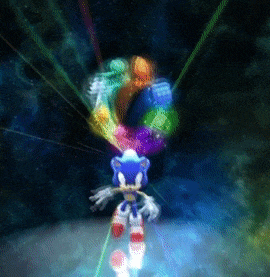
10.) Sonic Colors (SEGA, Nintendo Wii, 2010): Man, remember that brief, magical time from 2008 to 2012 where it looked like SEGA might actually be getting the "Sonic" series back on track? Well, "Sonic Colors", to my mind at least, is one of the very best games to emerge from that all-too-brief cycle, taking the day-time segments from the previous year's "Sonic Unleashed" and expanding on them beautifully. The new ways to traverse and explore the game's impressively-constructed stages added a nice amount of depth, collectible red rings lent the game a decent amount of replay value, and even the multiplayer mode managed to provide some amusing little distractions, as well as being cleverly integrated into the single-player campaign by playing a role in unlocking one of the game's big secrets. Heck, it even featured the debut of a new, significantly less annoying vocal cast for the "Sonic" characters. Sure, like a lot of Sonic games, it can be fairly rough around the edges, but isn't there something nicely poetic about one of the best things Sonic's done in the last decade being exclusive to a Nintendo console?

9.) Eternal Darkness: Sanity's Requiem (Silicon Knights, Nintendo Gamecube, 2002): These days developer Silicon Knights feels a bit like the sad punchline to a bad joke after the one-two punch of the disappointing "Too Human" and the atrocious "X-Men: Destiny". For a while there, though, their reputation was iron-clad, thanks in no small part to "Eternal Darkness", one of the most compelling games, not just for the Nintendo Gamecube, but indeed the entire console generation it was part of. Mixing Lovecraftian horror with wide-spanning time travel, it's one of the few games to evoke a true sense of existential dread, with the very concept of sanity itself being built into the game's mechanics. This forces you to witness the strain these incredible events really put on the player character's mind, and thus do your level best to wrestle against that ever present tide, only to find out how very difficult that fight is. Combined with branching paths to keep you coming back and compelling horror imagery that remains exceptionally potent all these years later (indeed, some of the game's cruder graphics almost enhance the effect), it makes for a truly haunting requiem.
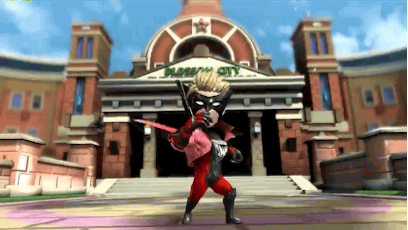
8.) The Wonderful 101 (Platinum Games, Nintendo Wii U, 2013): Even fewer games emerged to try to truly take advantage of the Wii U's unique game pad controller than did those which tried to really engage with the Wii's motion controls, but thankfully one of the ones which did was "The Wonderful 101", Hideki Kamiya's exuberant love letter to the Tokusatsu genre. Basically an Action Game take on the "Pikmin" series, "101" puts you in control of a massive travelling army of superheroes who can unite into various giant constructs to fight evil, with the Game Pad's touch screen providing a quick, easy way to draw up the relevant formations, as well as amusing mini-game segments that use the game pad to show you the inside of a building while needing you to observe the effects it has on the outside up on the TV screen. The design continuously finds clever ways to challenge the player, and like all Platinum game, it also has an airtight combat system that leans heavily on timing and reaction in the most viscerally satisfying way possible. All that, and it wears its visual identity proudly up front at all times, an aesthetic that is simultaneously wonderfully unique, even as it is also steeped in obvious, affectionate homage.
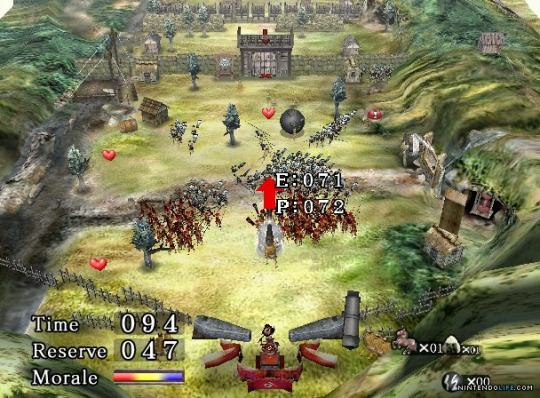
7.) Odama (Vivarium, Nintendo Gamecube, 2006): Here's a game few people have even heard of, let alone played. This is because, like most games which fit that description, it's a truly bizarre cross-pollination of genres. How bizarre? It's a Feudal Japanese War Epic...played through via pinball mechanics. If such a combination sounds impossible, all you need to do is give this truly one-of-a-kind experience a go, because once you do it'll make you wonder why more people haven't tried it. Giving the player a bird's-eye-view of various battlefields, you are charged with using your pinball flippers to try and guide the "Ninten Ball" (a massive, wrecking-ball-like pinball stand-in) to hit specific targets, flatten enemies, and try to clear a path to allow your troops to overtake the enemy's territory. Admittedly, the fact that this is a game of pinball, and thus often subject to as much luck as skill, can make even the early levels tricky to actually get through some times, and it does take a bit of time before the game's full, mythological tone takes hold. But even so, "Odama" makes its eclectic mixture work, and work remarkably well, pulling you in and keeping you going all the way, revealing new and ever-deepening layers to its game play without ever changing its fundamentals. If you can find a copy, you owe it to yourself to give it a try.

6.) Goldeneye 007 (Rare, Nintendo 64, 1997): Everyone knows the old conventional wisdom: licensed games suck, and movie games suck even harder. Yet the Nintendo 64 adaptation of the James Bond film "Goldeneye" doesn't just Not Suck, it's a stone-cold classic whose shadow still looms large over the entirety of the FPS genre. These days, of course, that's primarily attributable to its exceptional multiplayer mode, which even by modern standards shows an absolutely dizzying degree of customization to fit just about any group's preferred style of play. Want to keep certain stages off the rotation? Want to play with only a certain kind of gun? Want to change up how to win a particular kind of match? "Goldeneye" lets you. But the single-player shouldn't be taken for granted either, taking some of the movie's best moments and translating them perfectly into playable form. All that, and it's filled to the brim with brilliant deep-dive references for long-time Bond fans. No doubt about it, no one does it better than "Goldeneye 007".
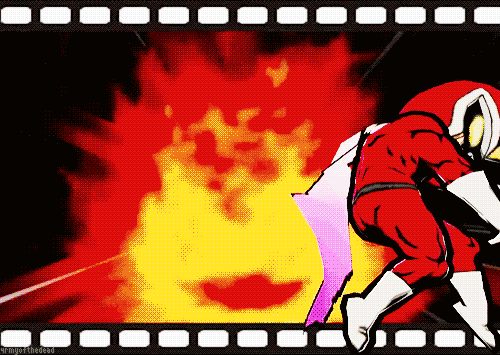

5.) Viewtiful Joe/Resident Evil 4 (Capcom, Nintendo Gamecube, 2003/2005) : The entire premise of this list rests upon Nintendo's relationship with third-party developers, and nothing is more emblematic of how poor said relationship has grown in the last two decades than the notorious "Capcom Five", a highly-promoted batch of five games from developer and long-time Nintendo collaborators Capcom, meant to be exclusive to the then-struggling Nintendo Gamecube...one of which was cancelled outright ("Dead Phoenix"), two of which were Gamecube exclusives that sold poorly ("P.N.03" and "Killer 7"), and then there were "Viewtiful Joe" and "Resident Evil 4", both of which proved popular enough to warrant Playstation 2 ports within a couple years of their respective releases. But even setting that contentious history aside, these two are indeed both fantastic games, one the stirring debut of a great new franchise from future "Wonderful 101" creator Hideki Kamiya (and steeped even further in his love of Tokusatsu, if you can believe it), the other quite handily the best of its notorious franchise, amping up its action elements while still delivering the shock and gore. Neither one could save the Gamecube from its premature demise, but both demonstrate a remarkable level of polish, innovation, and engagement. From "Joe"'s endearing sense of humor and fantastic fighting mechanics capturing the unique charm of the Super Sentai Hero, to "RE7"'s over-the-shoulder camera allowing the game to come at you full-throttle exactly when it counts most, they both prove themselves essentials for any Gamecube library, and a fitting last hurrah for that faded period of time when Nintendo and Capcom basically went hand in hand.
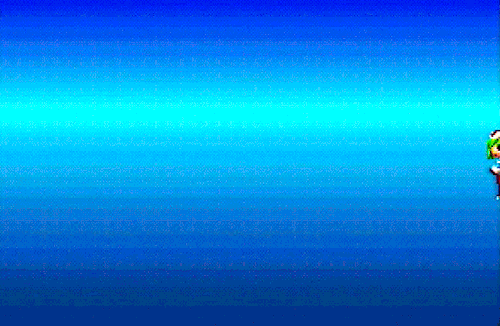
4.) Mischief Makers (Treasure, Nintendo 64, 1997): The release of "Super Mario 64" in 1996 revolutionized the world of video games in general, and the platformer genre in particular. Suddenly, everyone, from long-time favorites like Donkey Kong to lowly also-rans like Bubsy were pumping out 3D platformers in "64"'s image, and the genre's 2D roots seemed destined for extinction. It would take a lot of guts to put out a "traditional" 2D platformer in that environment, but sure enough, "Mischief Makers" had guts to spare, providing not only a refreshing alternative to the 3D glut but doing so with one of the most unique, best-constructed entries in the entire genre. See, rather than the usual hop-and-bop strategy, platforming in "Mischief Makers" instead centers on using special dash boosts to make your way to where you need to be, and shake-shake-shaking every last item you can get your hands on. It's not only a compellingly visceral new layer to things, but one the game explores thoroughly and creatively across its vast, well-varied selection of levels. Shake an object to transform it, or make it drop an important item, or get it to move in the direction you want; the game finds every angle it can, and each one succeeds. The Boss Battles are some of the most satisfying and challenging I've ever played, too. Even its story, loaded with sharp-witted humor and fantastically memorable characters, adds an extra layer of flavor to the whole experience. "Mischief Makers" was sadly underappreciated in its day, and hard to find nowadays, but even so, it's an absolutely great game.
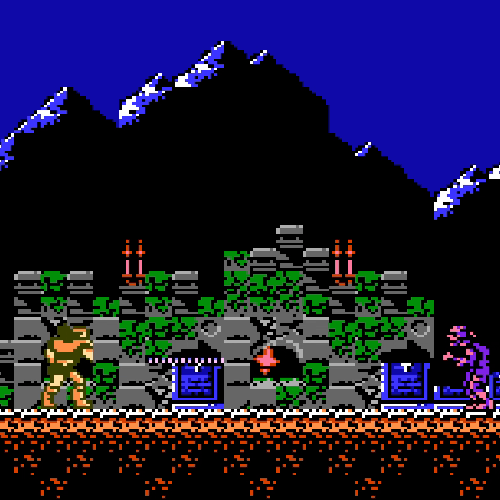
3.) Castlevania (Konami, Nintendo Entertainment System, 1986): Did you see that awesome trailer for the new "Castlevania" series coming to Netflix? Not only does it make the show look like it is going to be seriously great, it also serves as a stark reminder that, while it may have found renewed success and vitality as a Playstation game thanks to the iconic "Symphony of the Night", "Castlevania" began as, and is primarily associated with being, an NES game. And what an NES game it was, too. Throwing basically every last Horror Monster you could think of-Dracula naturally, but also the Frankenstein Monster, Medusa, and no less than the Grim goddammed Reaper-together into one place, mixed well with a unique take on the Gothic Horror aesthetic, and brought to life with some of the best graphics on the system, as well as some of its very best music, the original "Castlevania" offered up a compelling, challenging experience. Some of that challenge can be more than a bit cheap at times, it's true; like "Ninja Gaiden" (a game which just barely missed this list, for the record), the occasional clunkiness of the controls can lead to deaths that feel unfair. But for the most part, difficulty in "Castlevania" is earned by way of enemies equipped with tricky patterns, platforming designed to lead you right into the thick of danger, and managing your resources as best you can to insure they achieve the best effect. There's a lot of depth to the action here, with the wide variety of sub-weapons available to you and the situations you'll encounter. It all adds up into one of the best, most bizarre, most fascinating games to grace a Nintendo system.

2.) Final Fantasy VI (Square, Super Nintendo, 1994): Like "Castlevania", "Final Fantasy" is a series that, once upon a time, was primarily associated with Nintendo. But much like their relationship with Capcom, the Nintendo/Square (at-the-time-enix-less) partnership fell apart after the end of the Super NES, and "Final Fantasy" would go on to be much more a Playstation franchise from that point on. The good news, then, is that the last "Final Fantasy" game to come of that partnership is also one of the very best games in the entire franchise. It features one of "Final Fantasy"'s most memorable villains in the form of the genocidal mad-clown Kefka Palazzo. It features one of the series' most memorable, at-once-humorous-but-also-heartwarming sequences in the form of the notorious Opera performance. And it features one of the franchise's most ambitious narratives, one that takes you to the very literal End of the World and back again. Meanwhile, the aesthetic, the last time series mainstay Yoshitaka Amano would act as the primary character designer for the franchise, is gorgeously realized, pushing the Sci-Fi/Fantasy angle the series had been refining over the last several years to all-new places, and its soundtrack, composed by another FF veteran, Nobuo Uematsu, is justifiably legendary among fans. Most of all, though, it's just a gripping RPG from start to finish, taking all the things that had made prior "Final Fantasy" games work and polishing them to an absolute mirror shine. The combat, the travel, the customization options for your characters..."VI" marked the end of an era. But what an ending it turned out to be.

1.) Mega Man 2 (Capcom, Nintendo Entertainment System, 1988): It would seem nearly impossible to believe today, given the relative disarray into which Capcom has allowed him to fall, but once upon a time, Mega Man was one of the true stars of the video game world. And if you ever need to remind yourself of why, all you need to do is play "Mega Man 2" for the NES. It is here that the "Mega Man" series as we know it today truly begins, taking the rougher look, feel, and build of its predecessor and granting it a greater degree of polish, depth, and outright fun. The new Slide mechanic, for example, changes up the pace of the game's platforming considerably, while the more nuanced take on the previous game's rock-paper-scissors system for the various new weapons Mega Man can acquire provides the game with many of its most memorable moments (you ever try to use Metal Man's own weapon against him? You should!). The stages are all significantly better designed, too, with sharp, challenging traps mixing with pin-point precise run-and-jump segments, as well as some great new enemies to blast along the way. The music and graphics are aces too, finally fully realizing the Anime Sci-Fi Kid's Book aesthetic the series is now so well known for, and creating some of the most memorable music ever heard on the system (Dr. Wily's Castle is still an all-time great track). It even introduced Mega Man's iconic sidekick Rush the robo-dog, giving the character himself that much greater a sense of being a complete character by virtue of having a partner and friend to (literally) bounce off of. "Mega Man II" is one of Capcom's very best games ever, and it's the single best non-Nintendo game to hit a Nintendo console.
7 notes
·
View notes
Photo
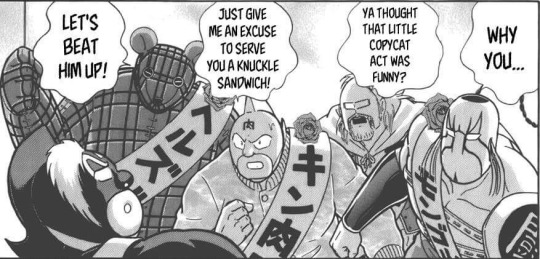
Let's do this.
Chaos Avenir debuts as a socially awkward teen(?) who is a huge Choujin and pop idol fanboy. Mantaro encounters him at a kid’s choujin wrestling show and the two hit it off almost immediately after beating up Chaos’ rowdy coworkers. Mantaro, believing Chaos to be a truly great wrestler, The Savior of The Justice Rest, drafts Chaos into the tag tournament. Easily convincing Chaos by appealing to his fanboyism, Mantaro notices Chaos’ possession of the Kinnikuman Great mask and Chaos decides to enter the ULTIMATE TAG TOURNEY as Kinnikuman Great the Third.
Chaos and Mantaro causes quite a ruckus when they debut at the tournament. Mantaro himself for being a show-off and Chaos for dressing like Kinnikuman Great. This act alone infuriates both of The Machineguns, both of them seeing it as disgracing Kamehame. Terryman in particular seeing it as an insult because he felt pressured to match Kamehame’s skill and yet here is this random person just dressing like Kinnikuman Great. It doesn’t help that Chao-Great 3 acts like a huge fanboy by filming his own walk towards the rings, and is acting like a buffoon in general. It doesn’t help that the first chance he gets to show his skill he trips and lands on his head. Chao- Great 3 adds more fuel to the fire by creeping out and/or harassing many of the fellow tournament competitors by doing things ranging from giving them custom figures of themselves to slapping paper on their faces.
Chaos Avenir’s relationships with others is probably the most problematic thing about him in terms of writing. Whether it is the new or old generation he in general is quite rude to them when he isn’t blinded by his fanboy love for said individuals. To describe it for those who may be familiar with American comics, imagine if Kamala Khan gushed about a hero and then spent a whole issue getting upset at them, with some reasons including said heroes being themselves. To be fair, he holds no real personal grudge against the Nisei era heroes despite more than likely seeing the controversial scene of Mantaro (unintentionally) letting Alisa get stabbed by the Death Watch Branding. But that doesn’t mean he likes the New Generation, either.
Chaos’ relationship with most of the Time Warp Choujin varies from contempt to casual indifference to some degree of respect. He never got to interact with Checkmate, save for seeing how messed up Checkmate is after losing his face. Barrierfreeman and Iryuhin also don’t directly interact with him, but are inspired by his skill against Neptuneman to act for his sake. But he does feel sad when he listens to their “final farewell” so that’s something. But he also has a flashback that may or may not have amplified his feelings as opposed to feeling sad due to the severity of the situation, either is really possible. Chaos’ relationship with Terry the Kid varies from being a fanboy spectator to feeling sad when Terry is in pain. But he does seem to respect Terry for being his dad’s son. It’s weird, because whenever Terry is seen and Chaos is around, panels usually focus more on Mantaro reacting than Chaos. But it seems like Chaos doesn’t dislike Terry, unlike some other Time Warp Choujin.
Chaos’ attitude towards the Time Warp Choujin takes a turn for the worse when he sees the Super Trinities (Jade and Mars) fighting against the Hell Expansions (Neptuneman and Seiuchin). When Mars is tagged in while donning his Mask of Madness and begins single handedly dominating the other tag team, it makes Chaos disgusted. Mars’ tactics and Mars’ goal to get the trophy bulbs for himself leads to Chaos stating the New Generation sucks. He sticks with this belief for a bit, to the point he even lashes out at Mantaro. It takes Jade’s heroic nature to turn that belief around for him. But he never really seems to care about Mars after Mars demonstrates his heel-ish attitude. You could say Jade is one of the members of the Time Warp Choujin that Chaos cared about most. He did go out of his way to make sure Jade kept his precious photo. Chaos spends most of his time scared of Seiuchin, but he does follow suit with Mantaro’s speeches about how Seiuchin isn’t actually a bad guy. He also does protect Seiuchin’s folks. So it’s sort of a tossup between Jade and Seiuchin for who Chaos cares about most from the Nisei era other than Mantaro.

Chaos’ relationship with Mantaro is pretty interesting. It puts Mantaro in a mentor role, something he’s never been in before. Mantaro as a mentor coddles Chaos to the point he would take a severe beating for him. Despite the (unexplained) belief that Chaos is human, Mantaro still goes pretty above and beyond for Chaos. Chaos meanwhile, spends at least a good half of his appearance constantly wanting to give up or doing things like ditching Mantaro. It’s almost incredible how much tolerance Mantaro has for Chaos’ childish antics. As time goes on, Chaos shows that he cares a lot for Mantaro. I personally think Chaos helped Mantaro become more selfless. The sad thing is that the relationship is a balancing act between Mantaro shining as a mentor/leading man with Chaos growing from a meek fanboy to the “super powerful plz do not nerf oc do not steal” mad man that he is before his “death”. And when the balancing act isn’t, well, balanced… their relationship seems to get worse. When Chaos is in control, you could say he isn’t really treating Mantaro like a friend, which is depressing considering how much Mantaro has stuck his neck out for Chaos and how much Mantaro clearly enjoys Chaos’ company.
Chaos’ relationship with many of the classic characters, from the moment he was introduced to them, is rocky. He comes off as a bumbling idiot for a good chunk of the tourney, he’s dressed like Kinnikuman Great, and he’s tagged with that asshole that hurt Alisa. Then he makes everyone look bad by basically being a big baby. First impressions are everything, and most of the legends’ first impression of Chaos is he cries often, spends time making figurines in the ring, may get lucky once in a while, spends more time running than fighting, and that he is dressed like Kinnikuman Great. No, rather, he is sullying the Kinnikuman Great line. Chaos himself spends a lot of time being disenfranchised in a way with how his idols behave compared to how he believes they should behave. A key example being most of his fight with The Machineguns is about him being upset that they are behaving in a heel-ish way, something that does not meet his standards. Despite, if he is such a huge fan he should know this, Suguru Kinniku always behaving in ways that can best be described as cheating. For example, stuffing his tights with forks and hammers. But no, Suguru claiming he does things such as bending someone’s finger to get out of a move is too much for Chaos despite Suguru’s past history. That totally ruins Chaos’ reality and… he doesn’t respect his Legends anymore.
Once Chaos loses his meek personality, he doesn’t really show any respect towards those he once idolized. But at the same time, more of his idols grow to respect him due to his skills and nothing else, really. Save for Neptuneman. Neptuneman liked Chaos because Chaos saved him. It overall leaves you with this weird feeling as Suguru cries once Chaos dies, because it feels more like it’s an obligation writing-wise as opposed to Suguru actually liking Chaos. Ramenman also really likes Chaos, to the point he appears in Chaos’ fever dreams sort of like how Jade does for Mantaro and Ramenman communicated mind to mind with Suguru. Although to be fair, Chaos and Mantaro humble Suguru and Terryman (because they apparently needed to be humbled), and also helped save Suguru and Mantaro when they fell out of the mountain ring. So, Chaos does have his positive moments with the legends.
While I have listed some of Chaos’ positive interactions, it’s really tough to say he actually bonded with people. Overall, they sort of felt like “Well, he’s sort of a nice guy…” mentality. He spends a lot more time yelling at people, saying they aren’t great, or just looking shocked. He doesn’t even really get along with Mantaro that well, unless he’s upset. Even Suguru, as petty as he can be, still got along with Kamehame as Kinnikuman Great. Chaos is like Suguru and Mantaro without the charm.
You can argue Suguru and Mantaro behave towards others similar to Chaos. Refusing to cooperate, petty, and quick to hold grudges. But beneath that exterior are two choujin who love their friends and have a very powerful moral compass. You can argue which of the two between Suguru and Mantaro is more of a jerk, but that’s for another day. Suguru and Mantaro thrust themselves into their friend’s problems, sticking their noses in to help out. Their noble personality draws others around them, their empathy is one of the things that keeps people around. Chaos is, from start to finish, Suguru and Mantaro but without their empathy. He spends so much time in his own little bubble despite being right smack dab in the action and panels for people to cry about their friends. This series that focused so much on friendship power just took a screeching stop to introduce this guy who treats almost everyone like crap for a vast majority of the time, everyone who comes to like him likes him after they beat him up, and he doesn’t even have time to care about their problems.
That’s horrible to me. He doesn’t fit in this series, and it really stands out when he’s arguably the main protagonist of all the volumes he is in. He just feels so out of place in this series. I really wanted to defend him, I really did, but after rereading every volume he is in numerous times… I can’t. He can be a nice person, sure, but again: He’s just Mantaro and Suguru without their empathy.
11 notes
·
View notes
Text
(ESSAY) The Ritual of Panic, by Rhiannon Auriol

Rhiannon Auriol situates panic in its personal, cultural and political contexts. With reference to fire festivals, witchcraft, film, visual art and literature, historical upheavals and contemporary crises, the essay considers the tensile, sometimes erotic, functioning of panic in relation to ritual, fetish, social boundaries and the pressures of adolescence.
> The opposite of an orgasm is a panic attack. It is also its twin. Both can leave you shaking. Breathless. Sweaty. You can have them in multiples (if you’re female-bodied), sometimes in a row for hours. There is a sense, to both, of a ritual release; once the last throes dissipate there is a violent shape of relief. And although the emotional aftermath of each is radically different, one thing is for sure – you always remember your first time.
> The ritual of panic is brutal and cyclical. I had my first panic attack aged 14. At school, they were reliable company. I would lock myself in a toilet cubicle when I felt one coming. I learned early on how to have panic attacks very, very quietly. Learned to carry all the right kit in case of an emergency rendezvous with my panic: tissues, makeup remover, water, gum, rescue remedy (I’ve graduated now to cigarettes and CBD). I have been panicking in this routine for years; all my life high-functioning anxiety has affected by ability to form healthy relationships with food, sex and work. I came of age nervously and erratically, swinging from confidence to collapse on a roughly six-month rotation. Terrified and in thrall to my panic, I was prepared to try anything to satisfy its crippling needs. And in this way my panic became ritualistic, a deity, pacified ineffectually by a private ceremony performed in bathrooms up and down the country. I got by without ever asking why I felt so trapped in this cycle, without examining what my struggle showed about the myth of worry that so many live by. Then I tripped over an essay by Fiona Duncan which struck home with its line, ‘Anxiety is a story I am telling myself’. My panic controlled me through my belief in it, I realised.
> Ritual, panic and sexuality are old lovers, intimate enemies. One of the definitions of panic is ‘of or relating to the god Pan’, the pastoral deity and mythological figure who has been portrayed alternatively as a kindly satyr or a sexual-Satanic symbol of ritualistic sacrifice. The myth goes that if the sleeping god was disturbed, panic would ensue, the flocks and herds of his slumberlands scattered by the resultant wrath. In order to placate the divine sleeper and avoid panic, animals were ritualistically slaughtered at Pan’s altars, ancient blood spurting onto stone in perfect harmony with the people’s nervous heartbeats. Pan’s association with nature also ties him to ideas of fertility and sexuality, to the rhythms of the seasons and their accompanying rituals such as the pagan celebrations of solstices and equinoxes. To an extent these festivals, as with many religious rites, are also sacrificial acts, alternative performances of homage to the power of the worshipped object (be it moons or gods) while also hoping for protection from fearful forces of change.
> There is something to be said for exploring the erotic element of these acts. As a child I regarded pagan celebrations in the same light as sexuality; they seemed mysterious and thrilling peaks of energy, climaxes if you will, strange and enchanting and (according to my Catholic mother) forbidden. When I moved to Edinburgh for university, I was free to go to the Beltane Fire Festival on Calton Hill, a ‘ritual drama’ and Gaelic celebration of May Day which throbs and flickers with sexual energy – from the raw allure of the dancing to the fierceness of flesh painted red, flowers of fire streaking the night sky. I saw how Beltane welcomed chaos and through this sense of liberation and lightness, the darker side of our impulses, panic, was staved off.
> It is possible however for the object of worship to become fetishised through rituals, symbolically distorted into something it is not. In the 18th century ritualism began to be associated more and more with notions of perverse sexuality, as did the god Pan. The goat-like form of the nature god began to take on a Satanic symbolism, largely due to Christianity’s moral panic over anything to do with sexuality and alternative deities, both of which Pan embodied. Consequently, people who worshipped Pan or Satan were denigrated by mainstream society as Satanists, pagans, witches. Demonstrating this shift in attitude with his Black Paintings series the 1798 Francisco Goya painting Witches’ Sabbath depicts a Satanic Pan surrounded by a coven of worshipping yet cowering witches. The great goat is garlanded and presides over the painting as if a priest in ceremony, the object of awe but also fear as indicated by its emphasised size and centrality to the composition, as well as the terrifying eye contact it maintains with the viewer. One of the witches clutches a baby, suggesting at first the Christian ritual of baptism, except the way the infant is grazed by one of the Devil’s hooves means it could also be a sacrifice, thus the baby is transformed into a signifier of both life and death. As a symbol of fertility, the baby also contrasts with the barren landscape of the piece’s background, which is littered with the skeletons of children. Such ominous depictions of Pan became rife, particularly in Europe at this time. And through such widespread portrayals, the concept of Pan was fetishised as the image became more powerful than the reality, especially when coinciding with proximity to moments in history such as the Basque Witch Trials. The tendency towards fetishisation taps into something fevered and feared stemming from how our societies are organised – the psychosexual release that comes for many with the mystery of worship is tempered by the craving to have control over a dominant wildness in our being, to shape power into a more limited comprehension.

Francisco de Goya, Witches’ Sabbath, 1789, oil on canvas. Museo Lazaro Galdiano, Madrid.
> From witchcraft to devil worship and paganism (among a plethora of other beliefs and practices), people get nervous about what they can’t comprehend. Deviant sexuality makes people panic. In fact, anything considered out of the norm does – that is why ‘witches’ were hunted. Witch hunting was political panic warfare, of a kind we still see today and have done throughout history under different names and faces, from the Red Scare to the Satanic Panics of the 80s. A lot of the time politics is about Eros, not Logos, as evident from looking at how it is emotionally guided voting which underpins the rise and normalisation of extreme and dangerous political phenomena – 20th century fascism, Donald Trump, Brexit. Each of these things could be described as having been fetishised by its supporters, while creating a sense of extreme panic or doom in its opponents. Susan Sontag describes how ‘the fascist dramaturgy centers on the orgiastic transactions between mighty forces and their puppets’ where the former requires placation and the latter worships or is punished. Sontag goes on to locate Nazi control within a cult-like eroticism: ‘the colour is black, the material is leather…’.
> On the 29th March 2019, incidentally the day that Brexit was supposed to have its chaotic way, I experienced a major depressive episode which lasted most of the following summer, triggered by a violent panic attack which woke me up in the night and made me see static. Mine was unrelated to Brexit (at least consciously) but others’ mental health is being disastrously affected by the Brexit cacophony, from counselling for MPs to the new term of ‘Brexit anxiety’ the uncertainty is eroding the country’s peace of mind. In failing to make sense out of public sacrifice – very literally, in the form of taxation, time and trust – the ritual of government has failed over Brexit, something which we are perpetually made aware of thanks to the fuel of media panic. Yet even amidst so much chaos, tradition and structure are clung to, the rituals repeatedly performed (Boris Johnson asking the Queen for permission to prorogue Parliament strikes me as a prime example), still hopeful of something changing, something miraculously being fixed. This is comparable to the more quotidian scale of ritual action. We seek control over things we cannot predict or see, all these things keep happening and there is no control over any of them, so we fill each day with things, with plans and schedules and jobs and lists to try and wrestle something back but only succeed in being so busy that we cannot breathe at night.
> As was the case with the mythological rites to Pan, vital things are sacrificed to my panic – relationships, money, time, happiness. The normalisation of the anxiety-inducing rites of passage which we describe as ‘coming of age’ is reflected in the documentary film All This Panic (2016) which follows a group of teenage girls through their Upper West Side lives in modern day New York, that city of anxious architecture and nerve-wracking streets. Throughout the documentary, directed by Jenny Gage, the girls exude a childish confidence which fails to mask their inner struggles with anxiety. ‘There’s all this panic…people are texting each other all the time… I’m petrified of getting older’ are just a few such indicative lines in the film which capture the sharp contrast between a mulled blasé outward attitude and the confusion within as the girls ricochet between casual crises. They are analogous characters to J M Barrie’s creation Peter Pan, a figure whose defining feature is eternal youth, a boy forever, fetishising the state of childhood. Peter plays the pan pipes, an instrument named after the god Pan, and in possessing the secret to flight appears to be a free spirit – and yet ‘he can never quite get the hang of [life]’.[i] Exaggeratedly careless, the iconic character appeals to the desire in readers to regain the laissez-faire boldness of youth. Today however, this idealised formative country is under siege. All This Panic portrays a post-wounded girlhood where beneath the ritual of performative femininity – make-up routines and coven-like cliques – is a terror at what may be waking, at what has to be covered up.
> What All This Panic highlights is how the milestones and expectations young people are expected to meet as they carve out lives for themselves are literally ‘rites’ exerting immense pressure upon the individual to follow them, to perfect each one: the correct clothes must be worn, the magic words that will make everyone want to be friends with you must be said, everything must be documented online, everyone must know when you start having sex for the first time, and you hide the 99% of things which don’t measure up to the pretty and perfected life – such as losing your mind. But what happens when these rituals fail, when the sacrifice is not enough, when things go wrong, and the sleeping demon is woken? Panic.
> The artist Laurie Anderson treats panic with a dose of hope in her video We Are In Constant Panic Mode. She would have us ‘try to see these great surges in a mode that’s not panic’. When a wave of anxiety approaches instead of drowning in it, we should ‘find a really good way to ride that. Fighting is a disaster’. What I took from Anderson’s observation is that perhaps the death of panic is found not in liberation from fear but in its acceptance. As the news that ‘The Great God Pan is Dead’ struck despair through the hearts of the ancient citizens of Palodes, they were simultaneously freed to explore new conceptualisations and interpretations of the world. We have a habit of killing our gods, of suffocating our emotional life, denying our desires. Perhaps after all it is not the panic which must be fixed, but the rituals we are restricted by. Rituals which are distancing us from nature and distorting our spiritual clarity – rituals which are creating, rather than placating, all this panic. But first there are more immediate things sufferers of anxiety can do – seeking medical help, taking (prescribed) pills, reducing intake of caffeine and alcohol, meditation and reconnection to the natural world. Like first figuring out how to have an orgasm, the body and brain must learn how to make positive joyful connections rather than repressing those pathways, and that is what anti-anxiety medicine can help create. The stigma around taking pills and the fearsomely described side effects led me to the most ironic panic of all – anxiety over taking my anti-anxiety medication. But I took it anyway and stepped outside the prison of my panic. And that is how the ritual ends.
~
Text: Rhiannon Auriol
Illustration: Maria Sledmere
Published: 19/3/20
[i] Barrie, J. M. Peter Pan. 2008.
0 notes